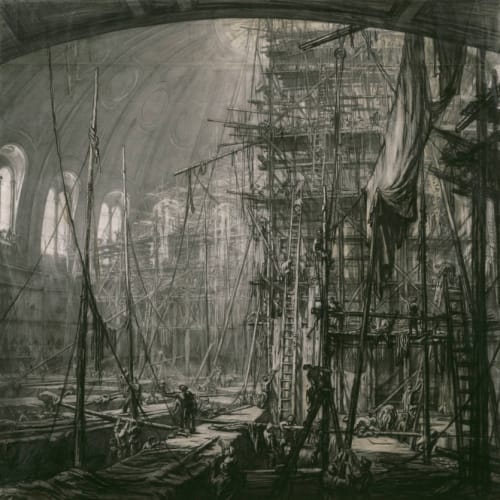Sir Muirhead Bone KBE NEAC RA RE (23 March 1876 – 21 October 1953) was elected a member of the New English Art Club in 1903 where he remained an active member until his death in 1953.
He was a Scottish etcher and watercolourist who became known for his depiction of industrial and architectural subjects and his work as a war artist in both the First and Second World Wars. Bone was an active member of both the British War Memorials Committee in the First World War and the War Artists' Advisory Committee in the Second World War. He promoted the work of many young artists and served as a Trustee of the Tate Gallery, the National Gallery, and the Imperial War Museum.
Early Life
Muirhead Bone was born in Glasgow. He qualified as an architect, before turning to art and studying at the Glasgow School of Art, originally at evening classes. He began printmaking in 1898, and although his first known print was a lithograph, he is better known for his etchings and drypoints. His subject matter was principally related to landscapes and architecture, which included urban construction and demolition sites, Gothic cathedrals, and Norman buildings. One of his first exhibited prints was a scene of Ayr Harbour, and the collection of his work held by the British Museum records his other works based in South Ayrshire, between 1898 and 1916. In 1900 he tried to run art classes in Ayr, from newly built premises at Wellington Chambers.
In 1901, Bone moved to London, where he met William Strang, Dugald MacColl and Alphonse Legros, and became a member of the New English Art Club. He held his first solo exhibition at the Carfax Gallery in 1902. Bone was also a member of the Glasgow Art Club with which he exhibited. Bone continued to visit Ayr, producing the notable prints of Ayr Prison in 1905 and a series based on the view of the Ballantrae Road in 1907.
First World War
During the First World War, Charles Masterman, head of the British War Propaganda Bureau, acting on the advice of William Rothenstein, appointed Bone as the first official British war artist in May 1916. Bone had lobbied hard for the establishment of an Official War Artists scheme and in June 1916 he was sent to France with an honorary rank and a salary of £500. Although thirty-eight years old at the outbreak of war, Bone was spared from certain enlistment by his appointment. Bone's small, black and white drawings, and their realistic intensity, reproduced well in the government-funded publications of the day. Where some artists might have demurred at the challenge of drawing ocean liners in a drydock or tens of thousands of shells in a munitions factory, Bone delighted in them; he was rarely intimidated by complex subjects and whatever the challenge those who commissioned his work could always be sure that out of superficial chaos there emerged a beautiful and ordered design.
Commissioned as an honorary second lieutenant, Bone served as a war artist with the Allied forces on the Western Front and also with the Royal Navy for a time. He arrived in France on 16 August 1916, during the Battle of the Somme and produced 150 drawings of the war before returning to England in October 1916. Over the next few months, Bone returned to his earlier subject matter, producing six lithographs of shipyards on the Clyde for the War Propaganda Bureau's Britain's Efforts and Ideals portfolio of images which were exhibited in Britain and abroad and were also sold as prints to raise money for the war effort. He visited France again in 1917 where he took particular interest in depicting architectural ruins. Two volumes of Bone's wartime drawings were published during the war, The Western Front and With the Grand Fleet. He was an active member of the British War Memorials Committee and helped select which artists received commissions from the Committee.
After the Armistice, Bone returned to the type of works he produced before the war and was influential in promoting fellow war artists William Orpen and Wyndham Lewis. He began to undertake extensive foreign travels, visiting France, Italy and the Netherlands, which increasingly influenced his work. In 1923, he produced three portraits of the novelist Joseph Conrad during an Atlantic crossing. An extended visit to Spain in 1929 resulted in the folio Old Spain, published in 1936. In the inter-war period, he exhibited extensively in London and New York, building up a considerable reputation. Bone received a knighthood in the 1937 Coronation Honours for services to art and he served as a Trustee and on the committees of several institutions including the Tate, the National Gallery and the Imperial War Museum.
Second World War
At the outbreak of the Second World War, Muirhead Bone was appointed a member of the War Artists' Advisory Committee and also became a full-time salaried artist to the Ministry of Information specialising in Admiralty subjects. He produced scenes of coastal installations, evacuated troops and portraits of officers. However, following the death of his son Gavin in 1943, he decided not to continue with the Admiralty commission, but he did remain an active Committee member until the end of the war. His other son, Stephen Bone, was subsequently appointed to the vacant Admiralty position.
Death
Sir Muirhead Bone died on 21 October 1953 in Oxford. His final resting place is in the churchyard adjacent to the St. Mary's Church, Whitegate at Vale Royal parish in Cheshire. He has a memorial stone in St. Paul's Cathedral in London.
Sources and Further Reading
This is an edited version of the Wikipedia entry for Muirhead Bone.
You can view a selection of Bone's paintings and drawings on the ArtUK website.
Header image: The British Museum Reading Room, May 1907, Sir Muirhead Bone, © The estate of Sir Muirhead Bone. Find out more about this specific artwork on the Tate website.
